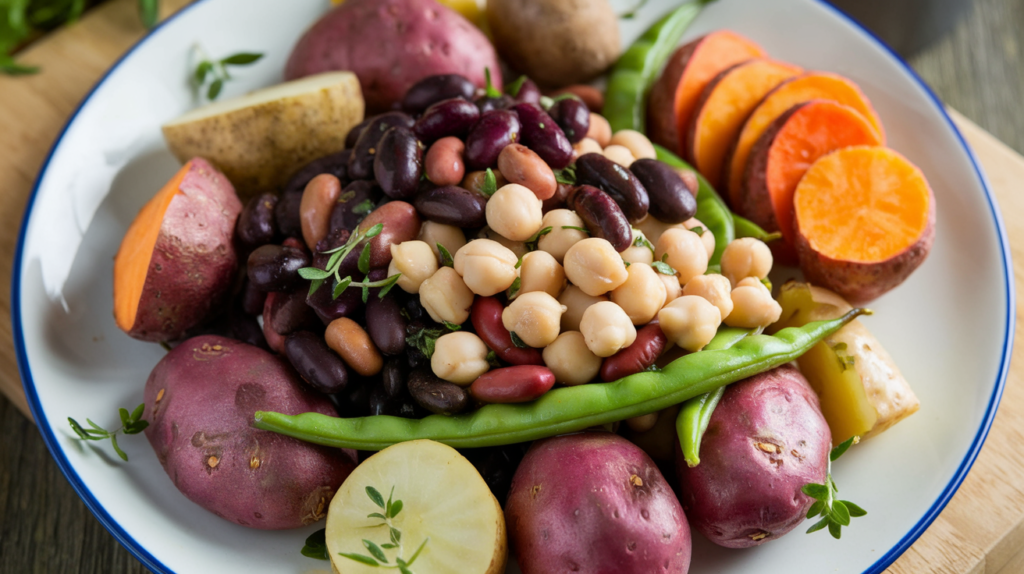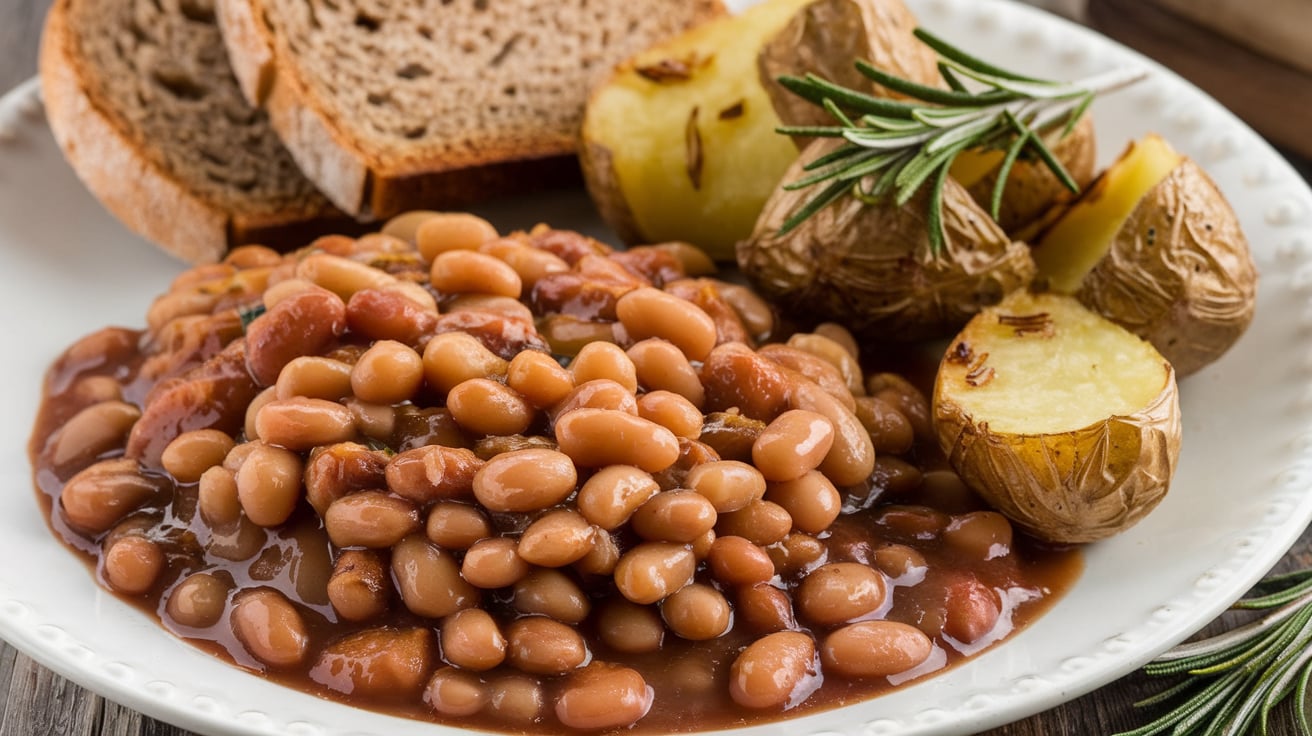Beans and Potatoes for Diabetics A Nutritious and Delicious Approach
Beans and potatoes for diabetics are a nutritional combination that offers a variety of health benefits while being flavorful and satisfying. Living with diabetes often requires making mindful food choices, but that doesn’t mean you have to sacrifice flavor. Both beans and potatoes are nutrient-dense, versatile, and affordable foods that can fit into a diabetic-friendly diet when prepared properly. In this article, we’ll dive into how beans and potatoes for diabetics can be included in your diet and the benefits they provide. We will also share some easy recipes for diabetics that focus on beans and potatoes. By the end, you’ll understand how to enjoy these foods while maintaining stable blood sugar levels.
Table of Contents
The Benefits of Beans for Diabetics
Beans are a nutritional powerhouse, rich in protein, fiber, and essential vitamins and minerals. For those managing diabetes, they provide several benefits:
- Low Glycemic Index (GI): The glycemic index ranks how quickly carbohydrates raise blood sugar levels. Beans have a low GI, meaning they release glucose slowly and steadily, helping to prevent blood sugar spikes.
- High in Fiber: Fiber is crucial for blood sugar control. It helps slow digestion and stabilize blood sugar. A diet rich in fiber has been linked to improved insulin sensitivity.
- Plant-Based Protein: As a plant-based protein source, beans help regulate blood sugar levels without the saturated fats found in animal-based proteins.
- Nutrient Dense: Beans are packed with nutrients like magnesium, potassium, and iron, which are important for overall health and blood pressure control—two key concerns for diabetics.
Are Potatoes Safe for Diabetics?
Potatoes are often viewed as a no-go for people with diabetes because they are starchy vegetables. However, when consumed in moderation and paired with other low-GI foods, potatoes can be part of a healthy diet for diabetics. The key is choosing the right type and preparing them in a way that doesn’t cause drastic blood sugar spikes.
- Choose Sweet Potatoes: Sweet potatoes have a lower glycemic index compared to white potatoes. They are rich in fiber, vitamins (like Vitamin A), and antioxidants, making them a healthier option.
- Boiling vs. Baking: Boiling potatoes is a better option for diabetics because it results in a lower GI than baking or frying. Cooking methods significantly affect how quickly potatoes impact your blood sugar.
- Portion Control: As with any carbohydrate, portion control is critical. A small serving of potatoes can be balanced with other high-fiber foods to reduce its glycemic impact.
- Combining Beans and Potatoes for Diabetics
Combining beans and potatoes for diabetics creates a balanced, diabetic-friendly meal. Beans provide protein and fiber, which slows the absorption of carbohydrates in potatoes. Here’s why this pairing works:
- Slower Digestion: The fiber in beans slows the digestion of starches found in potatoes, preventing quick blood sugar spikes.
- Balanced Macronutrients: While potatoes are primarily carbohydrates, beans contribute protein and healthy fats to balance the meal.
- Rich in Antioxidants: Both beans and potatoes, particularly sweet potatoes, contain antioxidants that reduce inflammation, which is beneficial for diabetes management.
Delicious Diabetic-Friendly Recipes with Beans and Potatoes

Recipe 1 – Sweet Potato and Black Bean Chili
This hearty sweet potato and black bean chili is packed with fiber, protein, and nutrients, making it perfect for diabetics. The beans and sweet potatoes create a balanced meal with a low glycemic load.
Ingredients:
- 1 medium onion, chopped
- 2 cloves garlic, minced
- 1 tablespoon olive oil
- 2 medium sweet potatoes, peeled and diced
- 2 cans black beans, drained and rinsed
- 1 can diced tomatoes
- 2 cups vegetable broth
- 1 teaspoon cumin
- 1 teaspoon paprika
- 1/2 teaspoon chili powder (optional)
- Salt and pepper to taste
Instructions:
- In a large pot, heat the olive oil over medium heat. Add the chopped onion and garlic, and sauté until softened.
- Add the sweet potatoes, black beans, diced tomatoes, and vegetable broth to the pot. Stir to combine.
- Add cumin, paprika, and chili powder. Season with salt and pepper.
- Bring the mixture to a boil, then reduce the heat and simmer for 20–25 minutes, or until the sweet potatoes are tender.
- Serve hot and enjoy!
This meal is a great option for diabetics because it offers a balance of fiber-rich beans and low-GI sweet potatoes.
Recipe 2 – Roasted Chickpeas and Potatoes
For a lighter option, try roasted chickpeas and potatoes. This simple recipe combines the crispiness of roasted chickpeas with the heartiness of potatoes for a satisfying side dish or light meal.
Ingredients:
- 2 cups cooked chickpeas (or 1 can, drained and rinsed)
- 2 medium sweet potatoes, cut into cubes
- 1 tablespoon olive oil
- 1 teaspoon smoked paprika
- 1/2 teaspoon garlic powder
- Salt and pepper to taste
- Fresh parsley for garnish
Instructions:
- Preheat your oven to 400°F (200°C). Line a baking sheet with parchment paper.
- In a large bowl, toss the chickpeas and sweet potato cubes with olive oil, smoked paprika, garlic powder, salt, and pepper.
- Spread the mixture evenly on the prepared baking sheet.
- Roast for 20–25 minutes, stirring halfway through, until the sweet potatoes are tender and the chickpeas are crispy.
- Garnish with fresh parsley and serve warm.
This recipe is low in fat, high in fiber, and offers the complex carbohydrates diabetics need for sustained energy.
Tips for Cooking Beans and Potatoes for Diabetics

While both beans and potatoes can fit into a diabetic diet, there are a few tips to ensure you’re making the healthiest choices:
- Choose Whole, Unprocessed Beans: Avoid canned beans with added salt or sugar. Opt for dried beans that you can soak and cook yourself, or choose no-salt-added canned varieties.
- Opt for Sweet Potatoes Over White Potatoes: Sweet potatoes have a lower glycemic index and offer more nutrients like fiber and vitamins.
- Watch Your Portions: Diabetics need to be mindful of portion sizes, especially when consuming starchy vegetables like potatoes.
- Add Healthy Fats: Include healthy fats like olive oil or avocado to slow the absorption of carbohydrates and help control blood sugar levels.
- Spice It Up: Herbs and spices like cumin, turmeric, and paprika not only add flavor but also have anti-inflammatory properties that may benefit blood sugar regulation.
- Frequently Asked Questions (FAQs)
Are beans and potatoes good for diabetics?
Yes, diabetics can enjoy both beans and potatoes when they are prepared healthily. Beans are high in fiber and protein, while potatoes, especially sweet potatoes, offer essential nutrients and can be part of a diabetic-friendly diet when eaten in moderation.
Can I eat white potatoes if I have diabetes?
White potatoes can be included in a diabetic diet, but they should be eaten in smaller portions and prepared in ways that minimize their glycemic impact. Pairing them with fiber-rich foods like beans can help reduce blood sugar spikes.
How often can diabetics eat beans and potatoes?
There is no strict limit on how often diabetics can eat beans and potatoes, but portion control is essential. Beans can be eaten more frequently due to their low GI, while potatoes, especially white ones, should be consumed less often and paired with other low-GI foods.
Conclusion
Incorporating beans and potatoes for diabetics into a diabetic-friendly diet is possible and highly beneficial when done correctly. Beans offer a rich source of fiber and protein that helps manage blood sugar, while potatoes—lovely potatoes—can provide valuable nutrients without spiking glucose levels. By following the recipes and tips, you can enjoy delicious, satisfying meals supporting your diabetes management.







